
The recent Supreme Court ruling striking down affirmative action once again highlighted an uncomfortable reality that a minority group (in this case, Asian Americans) mostly opposes a position held by the progressive movement and the Democratic Party. The response from the left was to depict Asian Americans — who, polls show, oppose the use of racial preferences in college admissions to increase diversity — as dupes or tools being used by white conservatives to attack other vulnerable minorities.
“The promise of proximity to whiteness and power has radicalized some Asian Americans on the right,” noted an NPR story that approvingly cited scholars who instructed that the conservative litigants “pitted Asian Americans against Black and Latino communities.” A Vox piece complained that, once again, “Asian Americans are cited by white conservatives to put down other minorities.”
But the reality is that most Asian Americans oppose racial preferences in education — by a 15-point margin, according to a Pew poll from last month — for perfectly cogent reasons that have nothing to do with white conservative manipulation. Because Asian American students tend to perform at very high levels, they earn far more positions at elite universities than their share of the population would suggest; plans to create a diverse or socially representative student body therefore come at their expense. The progressive impulse to blend meritocratic admissions measures with diversity goals, not only at the university level but also in many public magnet schools, has put a large group of Asian Americans in direct conflict with Democrats.
This is hardly a unique episode. The party’s most restive constituencies are increasingly racial minorities: African Americans and Latinos as well as Asian Americans. These constituencies remain heavily, even overwhelmingly Democratic but disproportionately compose the party’s moderate wing, which is why Republicans are beginning to eat into their margins.
Yet Democrats have had an exceedingly difficult time recognizing and acting upon this challenge. One reason is that acknowledging a Democratic constituency’s authentic disagreements with the party’s agenda implies the need for compromise, something progressives — or ideologues of any stripe — are loath to do.
Another, deeper reason is that it violates a deep, self-flattering Democratic Party assumption to acknowledge that the swing constituents being lost are heavily made up of non-white voters. It’s supposed to be racial minorities, who have experienced the most discrimination, pulling the party to the left with white people joining as allies. Progressive activists and donors have long assumed that simply mobilizing non-white voters would naturally pull the electorate leftward. The idea that the constituents pulling the party leftward are disproportionately white, and those resisting that pull are disproportionately not, contradicts the premise of a movement that has axiomatically equated socially liberal positions with the desires of minorities.
David Byler recently broke down the political inclinations of the three largest demographic blocs of Democratic voters: white college-educated Democrats, white non-college-educated Democrats, and Black Democrats. Across a slate of social issues, white college-educated Democrats had the most liberal views, Black Democrats the least liberal. A recent poll even showed that Black Americans, who are overwhelmingly Democratic, narrowly approved of the Supreme Court ruling banning racial preferences in college admissions.
From 2020 to 2022, Democrats lost 3 percentage points of voting share among Black voters and 7 percentage points among Asian American voters. They managed to gain back a point among Latino voters after losing ground during the Trump era. It has only belatedly occurred to Democrats that Latino voters are neither fixated on humane immigration policy nor uniformly progressive on economics or social policy. As Ruy Teixeira points out, Latino voters hold more conservative beliefs than white Democrats on a wide array of issues.
The gulf separating the Democratic Party’s progressive white college-educated base and its non-white moderates was on uncomfortable display recently during a protest in Rockville, Maryland.
The demonstration drew hundreds of parents denouncing the city school system’s depiction of LGBTQ+ and gender-identity themes and demanding that schools allow their children to opt out of those texts and lessons. They were met by a small number of counterprotesters waving Pride flags.
The demonstration was not especially distinguishable from similar ones at other schools that have been popping up across the country, except for one thing: As I scanned the news coverage, every single protester I saw was non-white, and every counterprotester was white.
Rockville has some idiosyncracies that would produce a racial divide this stark: The protesters were largely affiliated with African and Muslim immigrant communities that had religious objections to the school curriculum and viewed white people in Montgomery County as extremely liberal.
Progressives are too reluctant to discuss the increasingly undeniable reality that the Democratic Party is being pulled leftward by its white college-educated elite and is losing non-white voters to the Republican Party. Disinformation or some other form of ignorance is not what’s causing Democrats to lose these voters; they are making rational decisions based on their policy preferences. Democrats have moved to the left on social issues and are losing their most socially moderate voters as a result.
Now, Democrats can argue in some cases that these losses are an acceptable cost. Defending vulnerable minorities is one of the party’s core missions, and Democrats have generally been willing to pay a political price to stand in solidarity with targeted groups. I happen to be a secular Jew who is not terribly sympathetic to any of the complaints of these protesters, who leaned heavily on Christian and Muslim religiosity. I believe schools have an obligation to teach their students mutual respect for all their fellow students, including gay and trans kids.
But when the opposing party is dangerous and authoritarian, parties need to be very selective about which positions they’re willing to lose voters over. If Democrats are willing to lose non-white voters rather than compromise their social values, that’s a valid choice. But they should at least be aware of the choice they are making.
Instead, progressives view the problem as one of disinformation: If non-white voters are recoiling at the Democrats’ agenda, the hidden hand of conservative manipulation must be at work.
When the Muslim-dominated city government of Hamtramck, Michigan, voted to ban Pride flags, the Guardian blamed “outside agitators” for stirring up the issue:
While the situation in Hamtramck largely evolved on its own local dynamics, some outside right-wing agitators connected to national Republican groups have been pushing for the ban on Hamtramck’s social-media pages and voiced support for it at Tuesday’s meeting. They are from nearby Dearborn where they were part of an effort last year to ban books with LGBTQ+ themes.
After the 2020 election, a wave of stories attributed the shift of Latino votes toward Trump to “misinformation,” the most common deflection used by progressives to explain away minority voters’ inconvenient beliefs. The same method has been used to rationalize Asian American skepticism of racial preferences in school admissions. A report last year by the National Council of Asian Pacific Americans lamented “the disinformation fueled by WeChat against affirmative-action programs in local schools and higher education, pitting Chinese Americans against other communities of color.”
One irony is that the anti-misinformation industry itself produces claims that are at best highly questionable. One paper measured how many Latinos were susceptible to the “conspiracy theory” that Joe Biden was “under the influence of Black Lives Matter and antifa,” which melds a plausible claim with a false one. (BLM has exerted some influence over Biden’s presidency.) The NCAPA paper labeled the idea that affirmative action “promotes ‘reverse discrimination’” as “casteist disinformation.” But the reality is that Harvard’s efforts to create a diverse campus do involve subjecting Asian American applicants to higher standards than applicants of any other background. The policy includes a “personality” test that systematically finds Asian Americans have worse personal ratings than any other group:
One can argue that Asian Americans should have to accept the trade-off of this discriminatory policy to advance the larger social goals of producing a diverse elite.
Yet you don’t have to agree with affirmative-action critics or the Hamtramck City Council to recognize that theirs are actual beliefs that must be dealt with, not dismissed as false consciousness or “corrected” by the intervention of self-styled misinformation specialists.
Politics requires trade-offs. Many Democrats have been living in a fantasy world where moving left on every issue will help them by mobilizing more minority voters. If they recognized any voters they might lose in the process, they were dismissed as white Dixiecrats getting in touch with their inner Strom Thurmonds. If Democrats choose to allow their moderate voters to draft to the GOP, they should at least be aware of just who those swing voters are.


